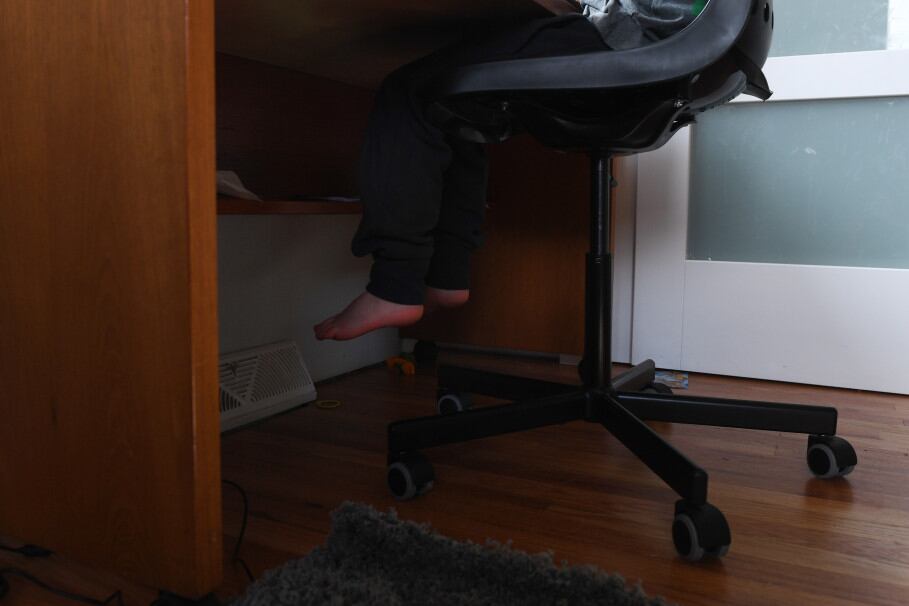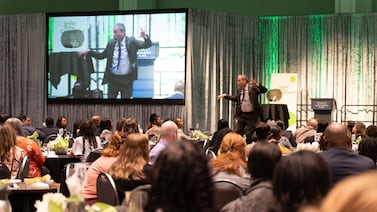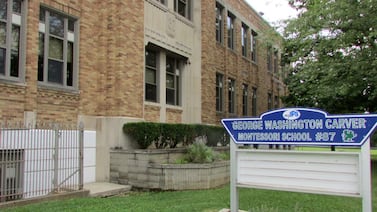Mortensen Elementary students in Littleton start their day from home at 8:30 a.m. listening to a phone message from their principal with the morning announcements — almost as if schools hadn’t closed to slow the spread of COVID-19.
After reciting the Pledge of Allegiance, they answer a daily question to log their attendance. They have two live instruction sessions per day, plus some online work in between.
At Deane Elementary in Lakewood, staff created a form where students who may not be able to answer a daily question can still check in daily. The school doesn’t require students to watch instruction in real time, where they could interact with teachers. Teachers record lessons and share the videos along with assignments online.
Students get new lessons on alternate days, with a day in between for practice and to allow students who might not be able to engage every day to catch up. More than a dozen students do work on paper packets they pick up every other week.
The two different models are examples of the various approaches to remote learning that schools in Jeffco have taken over the last two months.
Jeffco Public Schools was one of the first districts to jump into remote learning on March 17. The rigorous plan promised to reach every student, but was also designed to give schools choices including how to deliver instruction, or how to count a student as engaged.
“There was an intentionality about not scripting every move because we had not done this before,” said Superintendent Jason Glass. “Our strategy was to create infrastructure and support and allow our professionals flexibility to determine what worked best in their context. We needed that flexibility, especially in a community like Jeffco.”
Jeffco, the second-largest district in Colorado by enrollment, spans areas ranging from urban communities bordering Denver to wealthier suburban and mountain neighborhoods.
The efforts school leaders made to accommodate students may have helped increase engagement in some schools, but it often also meant less direct or live instruction, which might have an impact on achievement gaps.
Now, in the last week of the school year, Glass wants educators to reflect on their work so they can share what worked and what didn’t, especially as the likelihood increases that some remote learning will continue in the fall. District testing, which might occur this fall, might also help shed light on what worked.
“I don’t have any illusions that we’ve solved inequities,” Glass said. “Those gaps have widened.”
Mortensen and Deane serve different populations of students. About a third of students at Mortensen are eligible for subsidized lunches, a measure of poverty, compared with 85% of Deane’s students. About 50 Deane families didn’t have access to the internet in March. About 15 to 20 families still don’t. Mortensen’s principal is not aware of any family that still lacks internet access.
At Deane, about 73% of students are Hispanic and many are learning English as a second language. At Mortensen, the school has about 8% of its students learning English as a second language, and that includes students who speak 13 different home languages.
Principals tailored remote learning based on the needs of their communities.
Megan Martinez, principal of Deane, said that teachers have changed their practices over the last two months to better accommodate students. That means them making flexible arrangements for supporting and tracking the work of students with paper packets, changing their availability based on when students are more likely to be online, and creating multiple ways for students to be counted as present.
“As our students are able to connect with their peers and their teachers, we’re seeing more engagement,” Martinez said.
Jessica Hernandez, a parent of two Deane students, said remote learning has gone well. The teachers have been available any time she or her kids have had a question.
But, she said, she’s lucky that she’s able to stay home.
“It’s not an easy situation,” Hernandez said. “It’s not like they’re going to naturally say they want to do their work on their own. It’s always a team effort between students, parents and teachers.”
Hernandez said her biggest challenge in helping her children is not being able to speak English. Her children, a kindergartener and a second grader, both have learned English, she said, and they continue receiving language support, but she worries that she doesn’t pronounce English properly to model it for them.
“They learned a lot more English in school,” Hernandez said.
At Mortensen, Principal Karla Hankins said that when remote learning started, “It was like let’s just give the kids some purposeful learning and we’ll catch them up later.”
But as it became clear that the school buildings would remain closed for an extended time, Hankins changed her thinking.
“We have to actually teach the content we were going to teach,” Hankins said. “We can’t not teach them and then have two months of significant learning gaps.”
Hankins said teachers have been learning new features of their online tools to help with video instruction, such as being able to mute all students while the teacher is giving a lesson, and then opening up the mics to allow discussions.
In April, Jeffco also released broad guidance about attendance. Schools were to track student engagement daily, but it would only get entered into the district’s system weekly. That gave schools time to reach out to students before having to mark someone absent. Schools had flexibility in what they counted as engaged.
At Mortensen, students answer a daily question by 9:30 a.m. If they don’t, teachers reach out to families and can then accept late submissions or other work to count a student as engaged.
“We’re trying to give the parents, we call it giving them some grace,” Hankins said. “Bless their hearts, they’re not teachers. They’re trying to figure it out.”
Approximately 80% of students are “rising to the occasion” Hankins said, engaged daily and turning in high-quality work. Another 15% are engaged on a less active basis, while about 5%, or fewer than 20 students, have been unengaged. She said that includes some families that moved out of the district.
At Deane, students fill out an online attendance form just to check in. If they don’t fill that out, a teacher can also count other forms of engagement like answering a daily question, turning in assignments, or participating in a community circle video call.
“We know there are so many different factors and things that our families are dealing with,” Martinez said.
Older students are trying to take care of younger students, families still have unreliable internet, and some students may only be able to do work when parents are home from work.
Deane has had its best engagement in the last couple of weeks, Martinez said, with just about 2% of the school’s approximate 415 students counted as not engaged. Typically, Glass said low-income schools have faced more challenges in getting high engagement and not all have been successful.
Glass said many Jeffco schools have taken an approach similar to Deane’s. Many started remote learning trying to recreate school, but then realized they had to balance being available for students while also giving them flexibility in how and when they could do the work.
One factor that was top of mind for both principals was continuing relationships with students and families.
That’s why Hankins started sending out a recorded phone message with the morning announcements. In late April, she also started doing virtual Friday assemblies. And the school has spirit week activities including some that had neighborhood participation, like when students were told to count teddy bears in windows during an outdoor walk.
Martinez is doing weekly announcements through video shared on Fridays, including one recorded in Spanish. She also hosted some virtual parent meet-ups and the school is putting together a virtual talent show.
Parents say they have appreciated all of the communication with their schools.
Hernandez said her two kids have sent voice messages to their teachers, and love when they get to participate in live video calls where they can interact with their teacher and classmates — once a week for the kindergartner, and twice a week for the second grader.
“They’re fascinated by that,” Hernandez said. “They miss their teachers.”
Hernandez said she understands why more live video time is a challenge for some families. She used to work up to three jobs when she raised her first son, also a graduate of Deane and now a student at Metro State University of Denver.
At Mortensen, parent Roni Schad has been so grateful for how her school managed remote learning that she planned multiple activities for teacher appreciation week. On the final day, she organized a parade. She asked teachers to stand outside the school so students could drive by and wave and thank them.
She expected a few cars and a few teachers, but turnout far exceeded expectations.
“It was really touching,” Schad said. “It was a really good way to not only bring the school together but also make sure the teachers knew how much we appreciated them.”
Schad said many younger students, including her daughter Ylena, have been confused by all of the disruption this year. But it helped to see the teachers at the school.
She said, “It helped to end the year on a high note.”







